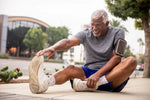National Sports Day: Our Top 6 Safest Sports

Whether you are someone who is moderately active or who has not been physically active in awhile, there are many forms of sports we can try to stay active, reduce stress, improve your overall health and be social. We know that living a non-active lifestyle is unhealthy, even risky for diabetics, but finding the right exercises to keep the body active and healthy. What exercises are safe and what steps can we take to reduce the risk of injury or aggravating our chronic conditions? We have compiled our top 6 safest and most beneficial workouts for type 2’s along with our safety reminders list as you enjoy National Sports Day this year!
Swimming is an ideal workout for the elderly, mainly because it presents little risk of injury and is low impact while making your heart stronger, larger and improving your cardiovascular health and endurance.
Dancing may help the maintenance of a healthy weight and balance, which are also important as we get older to prevent falls and fractures, improve muscle strength, posture and coordination. This can also be a great social workout.
Studies show Tai Chi can effectively affect the management of blood glucose in patients with type 2. This Chinese form of exercise uses slow, smooth body movements to relax the mind and body.
At home, in the park or in the gym, strength includes stretching, body weight exercises, resistance bands, weightlifting, or chair exercises. Strength training requires little time and minimal equipment. And it’s safe, even for people with health problems.
Walking 30 minutes a day reduces the risk of many conditions including heart disease, depression, obesity and osteoporosis while also improves our glucose control! We know that exercise helps our muscles absorb sugar, and daily exercise over time can prevent buildup in our bloodstream.
We know it might be a little uncomfortable to talk about or acknowledge but as we age all of our muscles need strengthening! Kegels are easy to do and can be done anywhere without anyone knowing. They are designed to help with problems of Stress incontinence - leaking urine when you laugh, cough, sneeze, jog, or lift something heavy. Urge incontinence - a need to urinate that is so strong you can't reach the toilet in time or Pelvic floor weakness due to childbirth. Find out how to do these exercises by clicking here.
Be safe always tips:
- Use Proper Equipment. Specifically focusing on the correct footwear! Replace your athletic shoes as they wear out. Wear comfortable and dry clothing, especially great socks and don’t exercise barefoot. Bring layers if you are going from cold to hot or vice versa.
- Balanced fitness. Having a variety of exercises, on alternate days with rest incorporated is a great way to achieve total fitness for your heart and muscles. Schedule regular days off from exercise and rest when tired. Fatigue and pain are good reasons to not exercise. While most of our top 6 exercises are safe to do every day, having variety in your exercise routine will keep it interesting, safe and the most beneficial.
- Warm Up. Warming up increases your heart and blood flow rates and loosens up other muscles, tendons, ligaments, and joints. It is the signal to your body that you are ready to exercise safely!
- Cool Down. Cooling down after your workout allows for a gradual recovery of pre exercise heart rate and blood pressure. Add 10 minutes to your workout time for this.
- Stretch. Stretching shouldn’t cause you pain, but you may have pain if you don’t stretch! Start slowly, hold each stretch for 10 to 20 seconds, then slowly and carefully release it. Inhale before each stretch and exhale as you release. Do each stretch only once. If something feels uncomfortable beyond or causes you pain, stop it immediately.
- Drink Water. Drink enough water to prevent dehydration, heat exhaustion, and heat stroke. Drink water an hour before your workout to ensure hydration while you engage in your sport of choice.
Summary:
Not only are our top 6 exercises the safest for people of all ages and with type 2 diabetes but they are virtually free and can be done in a variety of places, either alone or with others. We encourage you to incorporate these safe, affordable and versatile exercises into your 150 minutes of exercise each week.
You should contact your doctor before beginning any vigorous physical activity, especially if you have additional existing chronic conditions such as health problems, such as high blood pressure, a history of heart disease, or are a smoker.
Connect with our online community, support is at your fingertips and you do not have to feel isolated or be alone. Connect with other type 2’s today here.




